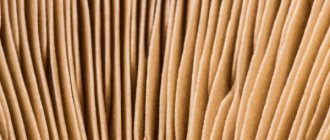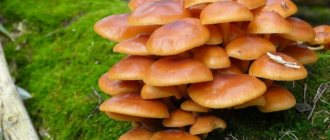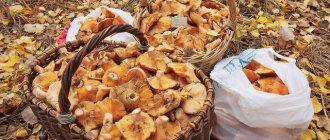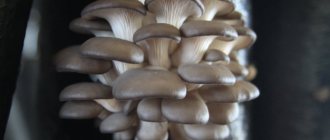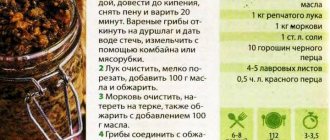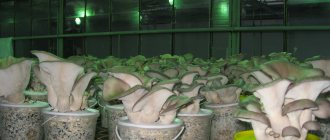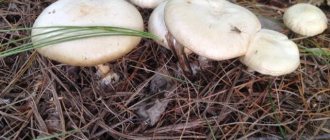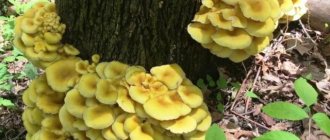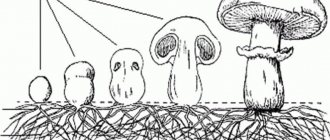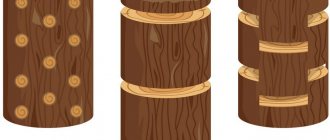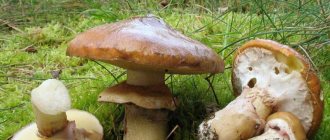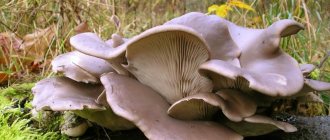Tasty and aromatic boletus is an excellent prey for a “silent” hunt: they are tasty both fried and pickled, and in winter you can make a dietary soup or main course from dried mushrooms. Forest boletus can be grown in your garden plot or dacha with only a little effort. Growing mushrooms is a profitable home business: experienced lovers of these forest gifts tell how to grow boletus in the country.
Forest boletus can be grown in your garden plot or dacha with only a little effort.
Description, biological features
Butterfly is a mycorrhizal fungus; it cannot be “settled” on stumps and sawdust; it grows only in symbiosis with a living tree: it supplies it with mineral nutrition and water, receiving sugars in return. With the help of sugars, the tree regulates the degree of growth of the mycelium so as not to lack nutrients. Therefore, mycorrhizal fungi bear fruit better in poor soils, especially where there is not enough phosphorus.
Granular oiler (Suillus granulatus) prefers calcareous (pH>7), sandy or clay soils.
Another popular mushroom, the true butterfly (Suillus luteus), avoids calcareous soils but grows primarily in sand.
Both form mycorrhizae with Scots pine (our most common type of pine). It is better to grow granular oiler in the garden: its yield is much larger. It grows under pine trees, mostly young ones, along the edges of pine forests. It is often found on plots of land reclaimed from arable land by pine forests. Mushrooms appear from May to October.
hat
Butterfly or butterfly mushrooms have a medium or small cap. Its shape is hemispherical; there are mushrooms with conical caps. Once fully ripe, it opens up and looks a little like a cushion. The maximum diameter is 15 centimeters.
The main difference between the mushroom cap and other species is that it is oily, with a very thin skin. It becomes covered with mucus if the weather is wet; some species have a velvety surface. The color of the mushroom skin varies from yellow to brown, and there may be spots. The color of the cap depends not only on the species, but also on the illumination of the place where the mushroom grows.
Pulp, hymenophore and cover
The spore layer or hymenophore has a tubular shape. Typically yellowish in color, it begins to darken as it ages.
The pulp of the mushroom is very soft and dense. Most often white, possibly with a yellowish tint. In the place where the mushroom is cut, the flesh may turn blue or red.
Butterfly or butterdish ages very quickly; after it appears above the surface of the earth, only 7-9 days pass until complete aging. The worm loves this type of mushroom very much, not only old specimens, but also young ones.
Some mushrooms have a connecting covering located between the stem and the cap. After ripening, the blanket breaks and a ring remains on the stem.
Leg
The mushroom has a cylindrical stalk. On average, its diameter is from 1 to 3.5 centimeters. Maximum height 10 centimeters. The color of the leg is white, with a dark bottom.
Sunflower pests and their control
Many pests love to eat oilseed sunflowers. The sunflower moth (lat. Homoeosoma nebulella) is most common. She lays eggs in the basket at the stage of its formation, and later the larvae hatch and gnaw out the seed kernels. Also common pests are: southern weevil, wireworm, sunflower longhorned beetle, and thorn beetle.
Moth larva on sunflower
The following will help reduce the likelihood of insect damage: treating seeds before planting, timely removal of weeds, and maintaining crop rotation. If pests are found, the plantings are treated with insecticides - Taran, Desiccant, Actellik.
Birds can cause great damage to crops. To scare them away, bright multi-colored ribbons are tied near the sunflower caps. They also use tinsel or old computer disks. Often, summer residents install a scarecrow on their property.
Protecting sunflowers from birds
Wrapping the heads with breathable fabric, such as gauze, will help protect the seeds from birds and pests. This should be done only after pollination and left in this form until the seeds are completely ripe.
Distribution in nature
The oiler chooses places in forest zones of temperate climates, preferring sandy soils rich in organic matter that have a light structure and have a high limestone content. The geography of its distribution is extensive - Europe, North America, Asia and Australia. In Russia, all kinds of boletus are found everywhere: from the forest-steppe zones of the Saratov and Voronezh regions to the Far East and Siberia.
Belonging to mycorrhizal fungi, boletus mainly grows at the roots of young coniferous trees and bears fruit for up to 15 years.
How to breed boletus in your dacha
A reliable method, proven more than once, is to transplant a small pine tree to the desired location. The fungal root of pine is the root system with mycorrhiza boletus.
A tree under which you can find an oil can will do. Any nearby is also suitable: in the forest, mushrooms connect all the trees of the same type.
When collecting mushrooms, suitable trees should be noted; at the right time in the fall, they are dug with a large lump of earth.
Trees take root well if you choose the time in late autumn or early spring and successfully preserve the main root.
By replanting a tree a meter high or more, you can expect a confident mushroom harvest in just 5 years.
Small trees about half a meter take root more reliably and are easier to replant, but the harvest will appear later. Butterflies can grow in grass, so pines are often planted on the lawn, no closer than 5 meters to each other.
Planting care
Mushrooms grow after rain; creating it artificially on the lawn is as easy as shelling pears. The grass will create a humid microclimate, and there will be a harvest even in the dry season. Watering is needed at least once a day; a spray system is also suitable.
The mushrooms will grow, annually increasing the distance from the parent tree, forming circles. Interestingly, butterflies from the lawn rarely become wormy: forest fungus gnats are blown away by the wind and do not have time to spoil the harvest in time.
Fruiting of mushrooms occurs in waves, several harvests per year.
How to properly transport mycelium
If you want to use the first method and simply transplant the mycelium, then you can do this even simply by finding a wild mushroom of the type that suits you. Among the advantages of this method, you can immediately notice a mushroom that has already matured and matured, and its active action will begin within a short period of time to improve the ecology of your site.
transplant mycelium
And so, you need to find the desired mycelium and carefully dig it out. Then you need to choose a location on the site. Places in the shade or under foliage are suitable. An area near a coniferous or deciduous tree is ideal and prepare a place for planting.
Which boletus will agree to grow in the garden?
Mycorrhizal fungi require symbiosis with living trees. Sawdust or old dead wood is not enough for them; only a living tree will give sugar to the fungus in exchange for minerals and moisture.
The tree supports the mycelium, allowing it to grow: in this way it maintains its vital activity. This is why poor soils are suitable for mycorrhizal fungi: in such places, trees especially need help.
Suillus luteus(lat) - real oil can
True boletus does not take root on calcareous soils, preferring sandy ones. A real oiler forms mycorrhiza with ordinary pine, which grows everywhere, especially in young pine thickets.
Suillus granulatus(lat) - granular oiler
This species is more likely to settle on calcareous soils, although it will accept sandy and clayey soils. It can be found under young pines, at the edge of the clearings.
It is especially abundant in young pine forests that have been sown on old arable land. The period May-October is considered mushroom season.
Both types of butterweed are suitable for the garden, but the granular one gives a noticeably larger yield.
The grainy butter dish is absolutely harmless even when raw, and is suitable for any dish. It has no poisonous counterparts, and can only be confused with another type of oiler.
Suitable for any preparations: marinades, pickling, freezer and dryer.
It is better to process a large harvest in the fresh air: mushroom spores can cause an allergic reaction, your eyes will water, your nose will run.
A frequent recommendation to be sure to remove the skin from the cap is due to the fact that with a real butter dish it is difficult to wash off adhering particles. Otherwise, it is completely harmless and does not spoil the appearance or taste of the finished dish.
Butter is simply made for light mushroom broth. If you add a couple of boletus mushrooms, or better yet porcini mushrooms, it will begin to smell like noble mushrooms.
Unfortunately, it is almost impossible to grow porcini mushrooms on the plot; they create a symbiosis with mature trees.
Boletus mushrooms - photo and description
All types of butterflies are quite similar to each other and differ mainly in size and color, as well as the shape of the cap. A typical representative of this genus is the common oiler (also known as true, autumn and yellow). The description of all other types comes down to listing the differences from the ordinary oiler.
All boletus have the classic cap-shaped fruiting body. Adult mushrooms are medium or large in size. The cap is hemispherical at a young age and flattens with age. One of the important distinguishing features of the boletus is the mucous layer covering the cap.
The key feature of boletus mushrooms, by which they are most easily distinguished from other forest mushrooms, is the tubular hymenophore. In the description of mushrooms, oil is the most important sign, for which novice mushroom pickers love it. The tubes under the cap leave no chance of confusing the butterdish with a toadstool or fly agaric, and the likelihood of encountering a poisonous tube mushroom in the forest is even lower than winning the lottery.
The leg of the butterfish is close in shape to a cylinder. In the vast majority of species, the remains of a private veil are preserved on it.
The flesh of butternut squash has a pale yellow or white-gray tint; when cut, it can take on a bluish or reddish color. Both the cap and the stem are eaten.
All types of butterweed form a symbiotic relationship with coniferous trees and cannot grow outside coniferous plantations. Butterflies are ubiquitous in the temperate climate zone of the Northern Hemisphere. There have also been numerous cases of unintentional introduction of boletus into more southern regions, including Africa and even Australia.
Now let's briefly look at the description of the butterfly mushroom of several of the most popular types:
- Ordinary oiler. A medium-sized mushroom (cap no more than 15 cm in diameter, stem height no more than 12 cm). The cap is covered with brown skin of various shades from dark chocolate to brown-olive. The tubular layer is yellow in color with small rounded pores. There is always a membranous ring on the white leg - the remains of a private bedspread. The fungus grows on the roots of Scots pine and other double-leaved pines. Prefers well-drained sandy soils. They do not grow on peat bogs, swamps and other moist soils. Distributed throughout the temperate zone. The common oiler can be found as early as June, but the fruiting bodies really appear intensively only in September-October. Active fruiting begins 2-3 days after rain. The fungus is highly susceptible to infection by insect larvae; the proportion of wormy fungi often exceeds 70%.
- The oiler is grainy. The mushroom is medium or even large in size (cap up to 20 cm in diameter with stem height up to 10 cm). The top film is lighter than that of the common oiler - light brown or even pinkish-brown. The tubular layer is a delicate pale yellow color. The granular oiler differs from all other oilers in that it does not have a membranous ring on its stem. The leg itself, as in the case of an ordinary oiler, is white. The mushroom received its name for the presence of more or less noticeable grains, similar to semolina, appearing on the stem. The fungus grows primarily on the roots of Scots pine and rarely symbiotes with other types of pine trees. Distributed everywhere, but bears especially abundant fruit in the Caucasus.
- Larch oiler. Medium sized mushroom. The diameter of the cap does not exceed 15 cm, the length of the stem is no more than 12 cm. The color range is from lemon yellow to chestnut. The flesh is also lemon yellow or pale yellow. The tubular layer is yellowish. It grows only next to larch, which is why it got its name. It grows everywhere in the European part, in the Urals, Siberia and the Far East on acidic rich soils. Fruits from July to September.
Due to the fact that all boletus are edible, there is no particular need to remember their species differences. The main thing to remember is that butter mushrooms have a tubular hymenophore, which allows them to be distinguished from poisonous lamellar mushrooms. You also need to remember that boletus grows only next to coniferous trees.
What conditions must be created for boletus when growing in the country or in the garden?
In order to get a harvest in a couple of years, you need to take care of comfortable conditions for mushrooms:
- Have several coniferous trees in your dacha. For boletus, pine is considered the most ideal partner. The age of pine trees should not exceed 10 years. Older trees will take a lot of nutrients and moisture from the soil, so oilseeds will be deficient in these components. As a result, the harvest will be meager, and the taste of the mushrooms will be far from ideal.
- Choose a location and prepare the soil. If these factors are neglected, the result will also be disappointing.
The most important condition when growing boletus in the country is to bring the environmental conditions as close as possible to those in which they grow in nature.
Prepare potato tubers for planting
To speed up the germination of potatoes, try this method: dip the tubers in hot water, and when it cools, add a little potassium permanganate. Then rinse the tubers, dry them, layer them with newspaper and transfer them to a warm place. After this procedure, after 3 weeks, strong, healthy shoots will appear on them. This way you will speed up germination!
For planting, select only healthy potato tubers weighing 70-100 g.
To prevent pests from touching the potatoes, you can place the tubers in a lighted place for 3 weeks. During this time, poisonous solanine is formed in them, which is easily identified by the greenish color of the peel.
Growing methods
Industrial cultivation is limited by the lack of highly profitable technologies that allow intensive cultivation methods to be applied in indoor conditions. Growing butterweed in production plots requires large areas of coniferous planting. Therefore, only amateur breeding of boletus has become widespread. The use of extensive methods, as close as possible to natural ones, allows us to obtain myceliums of high fertility and mushrooms of excellent quality.
There are several ways to grow wild mushrooms at home.
Taking into account the characteristic feature of oil beetles to form mycorrhiza only with the roots of young coniferous trees, the plantation for cultivation is selected based on the presence of at least several young pines, cedars, larch or spruce trees on the site. The exact tree species are determined by the type of boletus taken for cultivation and the immediate growing conditions of the mycelium from which the mycelium was taken.
At home, the most suitable age of trees is approximately 10, maximum 15 years. Young trees take a minimum of nutrients from the soil and water, leaving more food for the fungi. This proximity allows the mycelium to develop as actively as possible, therefore, the process of growing mushrooms will be the most effective.
Butterfly will not be able to live independently, without a patron tree
Breeding technology for different types of mushrooms
You can buy mushrooms for growing at home (seeds or spores) in a specialized store.
You can also prepare the substrate yourself. You need to take several fruiting bodies collected in the forest. Fill the caps with water, preferably rain or melt water. Leave for a day, then strain, grind the pulp into pulp, which will become planting material. The filtered water is used to moisten the substrate for growing mushrooms.
The substrate provides the planting material with the necessary nutrition for full growth and fruiting. For each type of mushroom, a specific composition is used, prepared independently.
Chanterelles
To grow mushrooms in the country and in the city, you will need a donor tree - spruce, pine or oak. A special substrate is also needed - turf soil, where the mycelium was dug up. The best covering material for mycelium is forest grass, pine needles, and moss. These components will provide the plantings with the necessary conditions that are as close as possible to the natural growing environment.
Growing forest chanterelles at home (in a basement, shed or on a windowsill) will not give positive results, since in such conditions the mycelium will not be able to fully develop.
White
For porcini mushroom mycelium, a nutrient soil mixture is prepared immediately before planting. Take ready-made store-bought soil containing peat (you can use the soil for growing indoor flowers). Mix with 1 kg of moistened pine sawdust and fallen leaves.
The mycelium is planted to a depth of up to 20 cm, the diameter of the holes is 10 cm, the optimal distance is 30 cm. By regularly moistening the substrate, you can get the first harvest in the second year of cultivation. In another year the amount of harvest will increase. This mycelium can live up to 5 years.
Champignon
The success of growing champignons depends on a properly prepared mushroom substrate. It will take about a month to prepare it.
- Take equal amounts of grain straw, horse and cow manure.
- Add a little superphosphate and ammonium nitrate.
- The prepared mixture is sterilized by pouring a solution of slaked lime (10 g per 1 liter of water).
It is stirred regularly for three days, then the mycelium is added. The plantings are regularly moistened with warm water from a spray bottle. A month later, they are covered with a transparent film with holes for oxygen access.
When the substrate is overgrown with mycelium, it is necessary to create a covering layer of 9 parts of moistened soil for growing seedlings and 1 part of powdered chalk. The mycelium is sprinkled with a thin layer of 2 cm. After a week, the film is removed and the soil is continued to be moistened regularly. The first fruiting bodies can be removed after 3-4 weeks.
Oyster mushrooms
One of the most productive species, which bears fruit several times a month, is oyster mushrooms. It can be grown in two ways.
- In a substrate made from plant waste, cereal straw, corn silk, sunflower husks and sawdust from deciduous trees are mixed.
- In logs. You will need medium-sized fragments, about 50 cm long and always with bark. For growing, it is better to use logs from healthy trees. They are cut off a month before the mycelium is planted. Drill holes 5 cm deep in a checkerboard pattern, maintaining a distance of 20 cm. Place planting material in them, then sprinkle with sawdust. Each log is buried 1/3 of the way into the ground. Further care consists of periodic watering. The first harvest will appear in six months.
Honey mushrooms
Winter species can be grown in different conditions - in an apartment, basement or greenhouse. When planting mycelium in closed ground, half-rotten logs and stumps with spore mash are placed in bags. The planting material is left in the greenhouse until the mushrooms germinate. They are often irrigated - every hour from 12 to 5 o'clock in the afternoon.
When growing indoors, use a substrate of sawdust from deciduous trees and bran (3:1). Soak in water for a day, then squeeze out, put half the volume in three-liter jars.
To destroy all pathogenic microflora, jars with the substrate are calcined in the oven. Then, after cooling, using a stick, make indentations to the very bottom with a diameter of 2 mm. Using a medical syringe, mycelium is placed into the holes and covered with a nylon lid. Until germination, the mushrooms are kept at a temperature of 20°C. Then transferred to a cooler room.
When the honey mushrooms reach the top of the jar, a paper cuff is put on the neck, which will restrain the growth of the mushrooms.
Soil preparation
The optimal soil for the development of mycelium is prepared as follows. In a selected area (preferably in partial shade, however, sunny areas are also suitable for butterflies), remove the top soil layer. Since the correct growing technology requires the formation of several layers of soil, plant materials, for example, chopped wood, grass, foliage, and pine needles are placed in the first layer. For the second layer, it is advisable to use soil collected from places where mushrooms grow, then it will have an acid-base balance that is as close as possible to the optimal one. You can take ordinary garden soil from your dacha. If necessary, humus can be added to it. Mycelium is sown on the soil prepared in this way.
Seeding mycelium
Although today it is not difficult to purchase boletus mycelium obtained in specialized laboratories, mushroom growers prefer to collect spores of overripe mushrooms in the forest. The reason for this lies in the nature of the mushroom’s nutrition, in which it receives most of the necessary organic substances from the patron tree. Therefore, successful cultivation requires a specific soil composition and tree species necessary for the formation of the symbiosis. For self-growing boletus, these conditions are of paramount importance, otherwise fruiting bodies may not form, despite the successful development of the mycelium.
It is not difficult to obtain mycelium from spores at home. To do this, the collected mushrooms should be mixed with a substrate prepared on the basis of a mixture of pine sawdust and peat and helps to create a nutrient medium close to natural. It is better if tree species suitable for growing butterweed are used for sawdust. Ideally, these will be the species next to which the mushrooms collected to harvest mycelium grew.
Growing mycelium occurs as follows. Half of the dried substrate is placed in three-liter jars, lightly compacted and filled with 1.5 liters of a special nutrient solution for mycelium. It is prepared from sugar syrup and yeast suspension (for 1 liter of water - 1 tsp sugar and the same amount of yeast). The solution is brought to a boil and poured into peat placed in jars. Fill the remaining volume of the jar with dried sawdust and close it with a tight lid. It will take approximately 5 hours for the substrate to be completely saturated with nutrients. The remaining water should be drained, the substrate should be mixed and pieces of mushrooms with spores should be placed in the puncture holes made with a stick. The jar is closed with a lid with a hole (about 1.5 cm) covered with a foam rubber stopper. Hyphae development occurs in approximately 3 months, at a room temperature of 23-25°C. A substrate with mycelium that is ripe for cultivation is stored in a cold (about 6°C) and dark room until sowing.
Planting material
You can find artificially grown mycelium of various mushrooms on sale. Mycelium from boletus costs from 120 to 300 rubles, depending on the type - the regular one is cheaper, and the cedar one is the most expensive. You can buy it in specialized stores.
Despite the abundance of choice of ready-made planting material, experienced mushroom growers prefer to independently grow mycelium from spores of overripe fruiting bodies taken from the forest.
IMPORTANT! Mycelium mycelium, obtained artificially in the laboratory, may not produce fruiting bodies under natural conditions, even if the mycelium develops well.
Where to plant mushrooms is the key to success
Each mushroom always grows only in certain conditions. Some mushrooms, such as morels or dung beetles, love warm, open areas and clearings, while others, such as white mushrooms, most often grow in the shade of trees.
Most mushrooms consist of 90% water (substantially less in polypores), so the most important condition for their successful development is high humidity.
In the scorching sun, any mushrooms dry out very quickly, so, as a rule, it is better to choose a place for growing them in a summer cottage or in a garden that is shady and as moist as possible.
At the same time, we should not forget that mushrooms still need light; it sets the direction of growth of the fruiting bodies. Without light they also grow, but worse, irregular in shape and color.
Light is not needed for the development of mycelium or mycelium, so royal mycelium or overgrowing blocks and stumps can be kept in complete darkness (for example, in a basement).
So, the ideal place for planting most mushrooms is the shade of trees in the garden, the north side of the house or barn.
If there are difficulties with the availability of such places, you can create a similar area yourself using a shading mesh, agrofibre, or just a piece of slate.
You also need to remember that mycorrhizal mushrooms: porcini, boletus, saffron milk caps, chanterelles and many others grow only in symbiosis with certain trees.
Boletus will never grow under a cherry tree, and garden entoloma will never grow under aspen or poplar.
For saprophytes (oyster mushrooms, champignons, honey fungus, shiitake, reishi and others), the proximity to a particular plant does not matter.
What to use for growing mushrooms
Stumps can be used for growing mushrooms. For example, if there is a stump left from some tree, don’t uproot it - here you can breed a whole family of honey mushrooms. Buy mycelium and go! There are even winter mushrooms, with which the stump must be “infected”
winter" in the fall. Don't worry, they won't die. On the contrary, in the spring, as soon as the sun warms the shadow, they will begin to grow. You can also choose a summer variety - you won’t go wrong either.
Then everything is simple: the powder with mycelium is diluted with water (according to the instructions) and the stump is watered generously. It must be loosely wrapped in film, in which a hole must be made so that the stump can breathe. After 2 - 4 months, looking under the film, you will see white mold. This is the mycelium. After this, the film must be removed, and then the harvest is just around the corner.
- Remember that the appearance of mycelium depends on temperature. The lower it is, the longer it takes for the mycelium to form. To grow honey mushrooms, stumps can also be cut down. Then bury it sideways into the soil up to halfway.
Good mushroom harvest when using a special solution
One of the ways to obtain fungal seed material is to prepare a spore solution (spore suspension). To do this, you need to take the mushrooms (it’s better if they are slightly overripe), break the caps and soak them in water for a day.
Mycorrhizal mushrooms are best collected under the trees under which they are planned to be grown in the garden plot.
Some sources recommend adding sugar to the solution as a nutrient medium, about 5-10 grams per 10 liters of water.
There is also a method for activating spores using yeast. Any yeast is added to the sweetened water in which pieces of mushroom caps are soaked to cause fermentation.
Subsequently, areas that are promising for growing the selected type of mushroom are watered with this solution.
The mushroom seed, spores, fall into the ground with water, where they germinate and form a mycelium if the event is successful.
Sowing mycelium from spores
Another way to grow wild mushrooms on a plot is to sow mycelium from spores. But keep in mind that the site must have enough trees and soil, like in a forest. Grind the caps of mature mushrooms or cut them into very small pieces. Add them to the water. Add 1 tablespoon each of flour and gelatin to the mixture. Water the soil around the trees with this solution and cover everything with dry leaves or mowed grass.
The spores will germinate, next year they will produce mycorrhizae, and the first mushrooms can be collected in 2-3 years. In this way, you can build an entire mushroom plantation if your site is located in a forest area.
Method of growing spores
Mushrooms reproduce both vegetatively (using parts of the mycelium or mycelium) and sexually: using spores.
Fungal spores are microscopic and are produced in huge quantities; different species can produce hundreds of millions or even billions of spores.
Therefore, it makes sense to use this method for growing mushrooms in your own summer cottage.
The simplest option is to simply scatter pieces of caps or peel mushrooms of interest in a suitable place in the garden.
The spores can be collected to be transported to another location or stored for future use.
To do this, place the opened mushroom cap on a sheet of paper or foil and leave for 12-24 hours, after which the cap should be removed.
The resulting spore print must be dried at room temperature, then it can be placed in a plastic bag for storage.
In the future, spores from the leaf can be scraped off with a sharp object and used to prepare a solution or simply scattered in a suitable place in the garden.
Spore prints can even be made on clothes that are used as work clothes in the garden, so the spores will constantly disperse throughout the area.
There is a possibility that some of the sown spores will germinate and form a mycelium. The more caps or spores used for sowing, the higher the chances that they will grow.
Champignons: planting and growing
- Mix 50 kg of cow or horse manure, 12 kg of gypsum and lime, 20 kg of straw.
- Combine everything together. You can add food waste to the composition.
- Compact the entire mixture tightly and sprinkle with water.
- Cover with plastic wrap and leave for several weeks until the ammonia smell disappears.
If you have decided to bring the champignon family from the forest, you should know some of the edible species. These include two-ringed, hymen, white, and garden.
Mushrooms, the growth of which has already begun, require practically no care, only watering during periods of severe drought. As for vertically growing varieties, they need spraying. In the spring, for some species, it is highly desirable to add a growth activator to the soil. Mushrooms do not need any other feeding. Moreover, loosening the soil is prohibited, as this can lead to damage to the mycelium.
Reproduction by mycelium
A very effective method is the propagation of mushrooms by mycelium. Unlike sowing spores, this method gives a more predictable result.
The mycelium of many mushrooms can now be purchased in garden stores or online: oyster mushrooms, champignons, shiitake mushrooms, winter honey fungus (flammulina) and others.
You will also need a substrate for growing. Champignons love compost, which is made from straw and bird droppings or cow manure.
The cooking process is quite labor-intensive. With oyster mushrooms everything is much simpler: it can be grown on straw, sawdust, hemp and even cardboard.
A simple way to organize a “mushroom bed” is as follows.
In a suitable place (shaded and moist), a shallow (10-15 cm) hole of the required length and width is dug.
Cardboard pre-soaked in water is placed on the bottom, a layer of mycelium is poured on top, then there is a layer of soaked straw or sawdust (you can mix these components), then again a layer of mycelium, and so on.
The bed can be covered with cardboard while the substrate fouls.
Caring for a mushroom “plantation” involves periodic watering by sprinkling, especially in the hot season.
The substrate should always remain moist, but not wet.
Stop weeds from growing
Weed control has always taken a lot of effort and time. This is completely unproductive work aimed at destroying a factor that impedes the normal growth of cultivated plants.
The traditional way to destroy weeds is by hand weeding with a hoe. The beds have to be treated every 2-3 weeks, since weeds quickly grow from the rhizome, plus new ones appear from seeds scattered throughout the garden.
How to prevent weed growth:
Green manure is an excellent fertilizer. 3 weeks after sowing, dig up the area, embedding the greens in the soil to a depth of 3-4 cm.
Agrofibre, unlike film, “breathes”. This is a lightweight material, strong and resistant to natural influences. No condensation is created under it, so the development of fungal diseases is not provoked.
Growing at home for beginners
Oiler is a mycorrhizal fungus - it forms a mycelium only near the roots of trees, mainly coniferous species. For successful cultivation, you need a place where several young pines or fir trees grow. You can accurately determine which type of butterfly is suitable for growing in your summer cottage by looking at the tree near which the mushroom was taken for cultivation.
If you have young pines or fir trees growing at your dacha, you need to take from the forest the mycelium of mycelium, which naturally grows under these trees. The maximum age of a tree is 15 years. The mycelium forms fruiting bodies in the second year after planting and bears fruit for 15 years. The younger the tree under which the mycelium is planted, the larger and better the harvest will grow.
REFERENCE: mushrooms that grow near young trees receive more nutrients. Pine and spruce trees older than 15 years take over almost everything, so the mycelium at their roots does not develop as intensively.
How to grow boletus at the dacha in open ground?
Oilseeds are planted in the spring. Before settling the mycelium in a permanent place, it is necessary to dig a hole of about 20 cm in the area allocated for them. Only in this way will it be possible to create conditions favorable for the development of the mycelium.
The nutrient medium for the mycelium is created from several layers:
- Fallen leaves, mown grass, chopped wood or sawdust are placed at the bottom of the recess.
- The next layer is soil. If the soil is taken from a personal plot, it is better to fertilize it with humus.
- The pre-propagated mycelium is spread in a thin layer.
- Plant materials are placed again.
- The last layer is garden soil. It can be taken from a garden bed or garden.
How to grow mushrooms: methods of propagation
To grow mushrooms yourself, you can use several methods of propagation: from mycelium dug in the forest, from mycelium (purchased, specially grown mycelium), from pieces of mature mushroom caps with spores.
Mycelium transplantation. With this method of growing mushrooms in open ground, a mycelium dug in the forest at a distance of 20-30 cm from healthy mushrooms is planted on the site along with a layer of earth 10-15 cm thick. It is placed in a prepared place near a tree growing in the garden. The planting area should be moist and shaded. Preferably trees of the same species as in the forest. First, within a radius of 50 cm from the trunk, the top layer of soil 30-40 cm thick is removed. The bottom of the “bed” is covered with compost, fallen leaves and sprinkled with earth. Then a forest layer with mycelium is laid on top. It is watered and sprinkled with fallen leaves. In dry weather, drip watering of the “beds” is carried out.
Planting mycelium. To grow mushrooms in the country using this method, you need a mixture containing mycelium, ready for planting. It is sold in packages. There are no foreign impurities or microorganisms in it, it germinates well, and grown mushrooms are less susceptible to disease. To plant mycelium, it is also necessary to prepare the place in advance. When planting in open ground, select a tree and remove the top layer of soil 50 cm thick within a radius of 50-60 cm around its trunk. The bottom of the “bed” is prepared in the same way as in the previous case, then the soil is poured in a layer of 10 cm. Mixed soil is poured on top with the remains of the mycelium soil and compact it. Cover the bed with soil, water it and sprinkle fallen leaves on top. You can pour ready-made commercial soil for growing mushrooms at the bottom.
Most gardeners, as practice shows, benefit from growing mushrooms that do not require special care (oyster mushrooms, champignons and shiitake). They grow well on a substrate with plant waste and mineral supplements, and also produce repeated harvests for a long time. Indoors or a greenhouse, these mushrooms can be harvested all year round.
To grow boletus mushrooms in your summer cottage, they should be planted under trees of the same species as in the wild. If the mushrooms selected for propagation grew, for example, under an oak tree, then planting material from them under a birch or spruce will not be effective. This is due to the close interweaving of the mycelium with the roots of trees for coexistence.
Planting parts of mushroom caps. The simplest method of propagation is to plant in open ground the caps of mature mushrooms containing spores, broken into pieces or minced through a meat grinder. Before growing mushrooms in a garden plot in this way, they are filled with water for a day. They dig up the soil under the tree and add soil from the forest to it. Then the bed is watered with mushroom infusion and pieces of mushrooms are laid out on it, and fallen leaves are sprinkled on top.
This video explains how you can grow mushrooms in your dacha:
Cultivation on an industrial scale as a business
It is unprofitable to grow boletus on an industrial scale, since it is impossible to do this indoors, and in open areas large areas with young coniferous forest plantations will be required. For this reason, only the cultivation of boletus at an amateur level has become widespread.
Having the opportunity to sow several dozen myceliums on a personal plot, it is quite possible to organize a small private business for growing boletus with their further sale. However, it will not be possible to make a big profit from selling butter to procurement points - prices in stores are too low.
Harvesting Rules
Usually in the first year the harvest is small, since the full development of the mycelium requires from 5 to 7 years. But with each subsequent year, the butter will become more and more. One mycelium continues to bear fruit for up to 15 years. As it ages, fresh mycelium is sown in its place.
In order to have a stable harvest every year, it is recommended to place several myceliums of different ages on the site. To do this, mycelium is sown at intervals of 1-3 years. In order not to damage the mycelium, boletus should be collected manually in the autumn, either by carefully twisting the mushrooms or cutting them off with a sharp knife at the root.
REFERENCE: The advantage of garden butter mushrooms over their forest counterparts is that mushrooms grown on the site with one’s own hands are almost always clean, without wormholes, since forest pests do not live in the garden soil.
By providing conditions for growing boletus at your dacha that are as close to natural as possible, you can get myceliums with high fertility and mushrooms of excellent quality. You can prepare a huge number of delicious dishes from boletus and freeze it for the winter. Potatoes and meat are stewed with these mushrooms, and fillings for zrazas and rolls are made from them. Well, the first place among Russians is, of course, occupied by classic marinated boletus.
Many people love mushrooms for their taste and dietary properties. Some people even try to set up mushroom farms on their own, producing oyster mushrooms or champignons. Is it possible to organize the cultivation of forest butterflies, for example, in your dacha? Fortunately, today growing butternuts yourself is not such a difficult matter.
The appearance of the butterfish is easily recognizable thanks to its brown oily cap covered with a sticky layer.
Nutritional characteristics oily
Butterfly in general and butterfly in particular are one of the most popular forest mushrooms. They are suitable for use in any form - in soups, fried, stewed, salted, pickled, in sauces and side dishes. Young boletus is considered especially tasty when marinated or salted. Although boletus mushrooms can be dried for the winter, they are rarely used in this form, since they darken when dried.
Butter in any form of culinary processing goes well with fried potatoes and mashed potatoes, goes great as a side dish for meat and fish, and is also very good in various salads. Although it is not necessary to remove the sticky skin from the cap before cooking, the flavor profile does improve when it is removed.
In addition to excellent taste, boletus is also characterized by excellent nutritional value and health benefits. They are rich in B vitamins, contain a lot of fiber, carbohydrates, amino acids, fatty acids and essential oils. All substances contained in oilseeds are easily absorbed by the body, and the lecithin present in them even prevents the deposition of cholesterol.
However, it should be warned that boletus also contains a lot of chitin, and this substance cannot be absorbed by our body, and therefore it is still not worth abusing boletus.
How does the mycelium take root?
Wild saprophytic mushrooms (purple row, oyster mushroom, winter honey fungus, fungus and many others) can be propagated by pieces of mycelium brought from the forest.
The necessary conditions for the development of mycelium are food and water.
Food for fungi that live on dead wood can be leaves, sawdust, straw or cardboard.
Having found a mushroom of interest in the forest, you can take part of the mycelium from which it grows, bring it to the site and plant it in wet sawdust or on soaked cardboard, cover it with a layer of sawdust or cardboard on top.
The mycelium should not dry out during transportation from the forest, so it is advisable to immediately put it in a plastic bag and plant it as quickly as possible.
If the outcome is successful, after some time the mycelium will begin to grow in a new place and master the substrate offered to it.
Honey mushrooms
There are several ways to start honey mushrooms in the country. The first and simplest is to find a stump with a family in the forest, uproot it and transport it to your site. If there are old trees nearby, then most likely in a couple of years new families will also appear on them.
The second way is to collect small chips from a fertile forest stump and immerse them in the crevices of a cut tree in the country. It is best to cover these places from above with moss or wood shavings. It is advisable to water or spray these plantings throughout the season.
Features of care and harvesting of oyster mushrooms
Oyster mushroom is perhaps the most common and accessible mushroom to grow even at home.
The easiest way to grow oyster mushrooms yourself is to purchase a ready-made mushroom block.
There are many such advertisements on the Internet. Detailed growing instructions can be obtained from the seller.
In the purchased block, 4-5 cuts are made evenly (if they do not already exist) about 5 cm long, after which it is placed for incubation in a dry, warm room (+18 +20°C), light is optional.
Or similar conditions should be provided outside: a dry, shady place. After overgrowing with mycelium (usually 14-20 days), the block is sent for fruiting.
For the formation of oyster mushroom fruiting bodies, high humidity, good air exchange and a fairly low temperature (+10 +20°C, depending on the strain) are required, so the best time to grow this mushroom outdoors is autumn, when nature itself creates suitable conditions.
There is also high-quality oyster mushroom grain mycelium on sale, which can be used to infect stumps (similar to honey mushrooms) or create “mushroom beds” next to vegetables or trees.
Suitable substrates include straw, sawdust from deciduous trees, sunflower husks, corn cobs, and cardboard.
The main condition is that the substrate must be kept moist and in the shade or at least partial shade.
The relatively low price and availability of oyster mushroom mycelium make it possible to conduct a variety of experiments on growing this mushroom in a summer cottage.
It is advisable to cut oyster mushrooms for consumption before they become overripe.
In such mushrooms, the edges of the cap completely unfold, a brown border appears on them, and a light spore powder is formed.
How to grow chanterelles
Yellow chanterelle (real) is a symbiont mushroom. For successful fruiting, the formation of mycorrhiza with a certain tree is required.
Most often these are oak, beech, spruce, pine, and birch.
If you have any of these trees on your site, you can try to sow chanterelle spores by scattering pieces of old mushrooms or watering the soil with a prepared spore solution (suspension).
The chances of growing yellow chanterelle from mycelium or mycelium are very low.
Growing porcini mushrooms (boletus)
The dream of every amateur gardener is to grow porcini mushrooms in their garden plot.
But it's not that simple. Boletuses are mycorrhiza-formers and bear fruit only if they create a symbiosis with a suitable tree.
It is known that the pine white fungus (Boletus pinophilus) forms mycorrhiza mainly with pine, but also with spruce, oak and beech.
The spruce porcini mushroom (Boletus edulis) has the greatest preference for spruce, pine, birch and oak.
Success can be achieved by collecting wild adult or even overripe mushrooms and sowing the spores under trees of the same species under which they were collected.
White, which is found under a pine tree, makes sense to plant also under a pine tree, and so on.
You can sow spores by scattering pieces of mushroom caps, preparing a spore suspension and watering the soil with it, you can also scatter spores from a collected and stored spore print.
Growing boletus mushrooms from mycelium or by transferring mycelium most likely will not work.
Boletus (redhead)
Boletus (boletus, redhead) is a name that combines several species of the genus Leccinum.
All of them are mycorrhizal fungi.
Red boletus forms mycorrhiza with aspen, pine boletus - only with pine, yellow-brown boletus - with birch, oak boletus - with oak.
Having the listed trees on the site and having found the appropriate type of boletus, you can sow spores from the collected imprint, scattering pieces of old mushroom caps or preparing a spore solution.
Using mycelium or mycelium is unlikely to be successful.
How to grow boletus
The boletus is also a symbiont. As you can guess from the name, it forms mycorrhiza with birch.
There is information that this mushroom grows in large quantities in young birch trees, so when planting birch on your site, you can try sowing boletus mushrooms.
An advisable method is scattering spores, watering with a spore solution, or scattering pieces of overripe mushrooms or peelings under the birches.
Growing saffron milk caps
The most common species found in our forests is pine saffron.
This is a mycorrhizal fungus that is “friends” with pine and prefers sandy soils.
It is even found in pine plantings, so if you have pine trees in your summer cottage, you can try growing this species.
Spruce camelina forms mycorrhiza, respectively, with spruce.
It is advisable to breed saffron milk caps using spores, pieces of old mushrooms, cleaning or watering the soil with a spore suspension.
Mushrooms in the garden plot
Old wormy mushrooms are an ideal option for propagation!
So collect a few from the forest and bring them home. And then there are several options. Randomly. It is enough to break the mushrooms into small pieces and scatter them under the trees. Spores will gradually spill out of the caps, they will fall into the soil and germinate. At first, a mycelium will develop underground - you will even be able to see it if, for example, you decide to plant something in this place. White threads in the soil, somewhat similar to mold, are mycelium. It will develop when there is a rainy year, fruiting bodies will appear - the very mushrooms that we were waiting for.
But this option is risky, because dry weather may set in, and then the spores will not germinate.
On tap. This method is more reliable, but more troublesome. Caps of old mushrooms (8 - 10 pieces, but the more the better) should be placed in a bucket, filled with water and left for a day. Then knead them directly in the water with your hands until smooth.
To sow around young trees, you need to remove a layer of soil 15-20 cm deep along the diameter at a distance of 1 m from the trunk. Do not dig a hole, but carefully remove the soil in a layer. Pour the mushroom mixture and water evenly onto the bottom of the trench. One bucket should be enough for 3 trees. After this, the layer of earth must be returned to its place, slightly compacted and watered.
Such crops will need to be watered all summer, once a week, 4 to 5 buckets per tree. And cover it with fallen leaves for the winter.
This option for propagating mushrooms usually gives a 70 - 75% chance of a harvest.
From the forest mycelium
This method gives more guarantee, but it will require physical strength. The bottom line is this: around the found mushroom you need to remove a layer of turf 20 cm thick and about 30 cm in diameter (but more is better). And transfer this layer to your garden.
In the garden, you need to dig a hole under it, but with a larger diameter and a little deeper - about 22 cm. At the bottom of the hole you need to lay wet sawdust in a layer of 1 cm. The sawdust should be from deciduous trees, if the mushroom grew under deciduous trees, or from conifers, if found it under coniferous trees. Forest turf with mycelium is installed on the prepared bed. And the gaps that have formed along the diameter are tightly filled with a mixture of sawdust and forest soil (1:1). Of course, the planting needs to be watered.
With this method, the mycelium will gradually begin to grow throughout the garden and, quite likely, will provide you with a harvest this season.
From mycelium
Nowadays, garden centers and online stores sell the mycelium of various mushrooms - the packaging is similar to seeds, but a little larger in size. Mycelium can be found on different substrates (it depends on the type of fungus), so the sowing methods also differ.
On a grain substrate. Chanterelles, porcini and Polish mushrooms, butter mushrooms, oak mushrooms, goat mushrooms, boletus mushrooms and boletus mushrooms are sold in this form. The sowing scheme is indicated on the package.
First of all, around the selected tree you need to remove the top layer of soil with a depth of 10 - 20 cm and a diameter of 1 - 1.5 m. Soil with a high peat content is poured onto the prepared area in a layer of 1 - 2 cm (soil for indoor plants from the store is suitable). Pieces of mycelium from a bag are laid out on it (1 bag per 1 tree). The removed soil is returned back. The sown area is carefully watered so as not to wash away the soil.
For the winter, crops need to be insulated - mulched with moss, leaves, branches, coniferous spruce branches.
In subsequent years, the area will need to be watered if there is no rain. It is also useful to feed the mycelium with a sugar solution: 1 tbsp. spoon per 10 liters of water.
On wood sticks. This sowing option is for mushrooms that grow on stumps and trees: oyster mushrooms, honey mushrooms, nameko, shiitake, blackberries (lion's mane) and tremella (ice mushroom). Growing them is not an easy task, but it is a very interesting activity! Sowing of such mushrooms is carried out in 3 stages.
Prepare the basis for growing - a log. Its diameter and length are not of fundamental importance, but it is more convenient to use the same logs as sawing for firewood. It is advisable that the log be fresh - 1 month after cutting. If it is old and dry, then it needs to be soaked in water for 2 - 3 days to become saturated with moisture, and then the water should be allowed to drain.
Then the log, saturated with moisture, is removed to a warm room, where it should rest for several days.
The log is populated with mycelium. First of all, you need to drill holes in the prepared log with a diameter of 0.8 cm and a depth of 4 cm. It is better to make them in a checkerboard pattern at a distance of 10 cm from each other. Usually there are 12 sticks in a package with mycelium, so there should be the same number of holes (1 package per 1 log).
Next, the sticks infected with mycelium are inserted into the holes until they stop. Important! This should be done wearing sterile gloves, and if you don’t have them, thoroughly wipe your hands with alcohol.
Tips for beginner mushroom growers
Some summer residents, wanting to grow boletus on their property, follow all the basic steps, but do not get good results. This is due to some mistakes that are made due to ignorance or lack of experience:
- There are several types of butter, differing in taste and requirements for growing conditions. For planting in the country, it is best to choose a yellowish or ordinary butterdish. Both species belong to the second category of edibility and are widespread throughout Russia.
- It is important to add soil to the soil from the place where the boletus grew in the forest. This is an ideal soil option. In this case, the yield will be much higher.
- You cannot loosen the bed. Inexperienced summer residents believe that this technique improves air access. In fact, they simply injure the mycelium, which may collapse and not bear fruit.
- The harvest must be harvested correctly. The legs must be cut off, even if only the caps are needed. The leg left on the bed begins to rot and infects the rest of the mycelium.
- It is recommended to cut mushrooms young. It is better not to leave overripe and wormy ones at the planting site.
By following simple recommendations, you can grow tasty and healthy boletus in your summer cottage without financial investment.
Buy ready-made seedlings
It is easier and often cheaper to buy seedlings than to grow them yourself. There are people/companies that professionally grow seedlings in large greenhouses. Optimal growing conditions are maintained there.
Many gardeners spend time growing seedlings, believing that this is the only way to get healthy, uninfected seedlings. In fact, there is no guarantee that such seedlings will be healthy and will not develop blackleg or other dangerous diseases.
The best solution to the issue is to find a reliable supplier of seedlings, then you can save a lot of time and effort on growing them.
